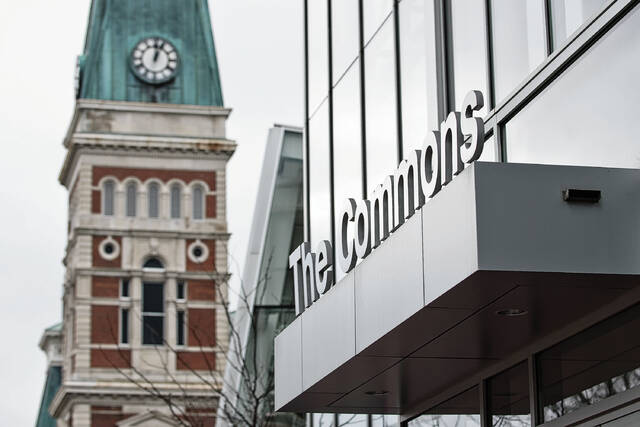
Pictured: The Bartholomew County Courthouse is pictured behind the Commons on Jan. 24, 2017, in downtown Columbus. Mike Wolanin | The Republic
Local officials have started to dip into their share of $350 billion in federal pandemic aid allocated to state, local, territorial and tribal governments across the country, though proposed uses for the funds are still advancing at different speeds.
In May, Bartholomew County received $8 million in federal funds through the American Rescue Plan — a sweeping $1.9 trillion economic stimulus package that aims to help communities bounce back from the COVID-19 pandemic.
The city of Columbus received $4.2 million. Both governments expect to receive a second installment of roughly the same amount next year.
The money can be spent on a wide variety of programs and projects, including replacing lost public sector revenue, investing in water, sewer and broadband infrastructure, premium pay for essential workers, among other things, according to the U.S. Treasury.
The law gives local governments until the end of 2024 to make spending commitments and the end of 2026 to spend the money. But any money not committed or spent by then must be returned to the federal government.
Nationally, many state and local governments have been slow to spend the money. As of this summer, states had spent just 2.5% of their initial allotment and large cities had spent 8.5%, The Associated Press reported in October.
Locally, county and city officials have started to spend some of the money they have received — including a collective $1.26 million this week, according to local records.
This past week, Columbus Board of Public Works and the Bartholomew County Commissioners awarded nearly $905,000 of the funds they’ve received to 12 local nonprofits whose bottom lines had been hit by the pandemic.
The Bartholomew County commissioners also has approved using its initial allotment to bankroll $357,750 in premium pay for many county employees who were required to work in-person last year as COVID-19 tore through the community.
The premium pay approved Monday — one-time payments of $1,500 for full time employees and $750 for part-time workers — covers nearly 55% of the county’s 456 employees.
However, more premium pay may soon be on the horizon, said Bartholomew County Commissioner Larry Kleinhenz.
Since announcing that certain departments would receive hazard pay, “the phone has been ringing off the hook” in the county commissioners’ office “with complaints from employees” whose departments weren’t included, Kleinhenz said.
In response, county officials will revisit the topic and consider whether employees in other county departments will receive the extra pay, though officials are bound by “very specific” federal criteria, Kleinhenz said.
“We already found a couple of departments that we felt like should have been approved and kind of just slipped through the cracks,” Kleinhenz said. “…We really want to be fair, and if anything, we want to err on the side of our employees. But there will be an accounting for these funds. And, you know, we have to make a report on how we spent these funds.”
Cautious approach
City officials say they are taking a cautious approach for how they plan to spend the city’s initial allotment.
In May, the Columbus City Council passed an ordinance that created a special fund for the federal money. As of Wednesday, about $604,000 of the $4.2 million in the fund had been spent, according to city records.
The city has spent $557,397 to help nine local nonprofits. The city has also allocated $21,645 to TD Advertising for pandemic-related advertising, website updates for the local COVID-19 task force and other work, $15,000 to Reising Radio Partners and $10,000 to Southern Indiana Housing and Community Development Corp. for work related to preparing a grant application for Indiana’s Regional Economic Acceleration and Development Initiative.
City officials have put together a draft plan on how the remaining money would be allocated, but the uncertainty surrounding how the pandemic will evolve has factored into the city’s decision-making process, said City Director of Finance, Operations and Risk Jamie Brinegar.
“It was highly recommended that we not rush into spending it because we’re not out of this yet,” Brinegar said. “We’re still in the midst of a pandemic. If we have another case where we have to shut down our offices and things like that or businesses, we don’t want to be out of this money and not have any to spend and help people.”
The plan includes $1 million to upgrade water and sewer infrastructure in downtown Columbus, including the a water main on First Street and upgrades along Fourth Street.
It also includes $1.1 million for revenue loss, $500,000 for Alliance for Substance Abuse Progress projects, $300,000 for “housing needs,” $100,000 for computer equipment for remote work and WebEx capability and $60,000 for public communication on the pandemic.
An additional $125,248 was listed as to-be-determined emergency needs and administrative assistance.
“We’re trying to be very judicious with the spending of this money to make sure it’s being used appropriately and to not run out of it before we’re completely through this pandemic,” Brinegar said.
Full speed ahead
In contrast, the county government appears to be moving more quickly on some of its plans, with a couple projects possibly starting next year.
In June, county officials unveiled preliminary plans for how it plans to spend the money, including $4 million on expanding access high-speed broadband internet.
Kleinhenz said the county has already seen “a lot of interest from three or four big companies” since advertising for proposals.
The commissioners will open the bids they have received during their Dec. 20 meeting.
If all goes well, Kleinhenz said, “hopefully by mid- to late 2022 we’ll see a groundbreaking for this new county-wide project.”
Other plans
Additionally, the county plans to spend $450,000 to $500,000 of the funds on sewer and water improvements on property on the southwest side of the county that is currently leased to the Bartholomew County 4-H Fair Board, Kleinhenz said.
“For many, many years — actually, several decades — we’ve needed to make water and sewer improvements there,” Kleinhenz said. “And so this (funding) kind of gave us the opportunity to do that.”
“We’re hopeful that we could get that started and completed before the fair next summer,” Kleinhenz added later in the interview.
Other items included in the preliminary plan included aid for rural fire departments and townships are still in the works.
“We were trying to get it done by the end of the year, and I think that is still the plan,” Kleinhenz said.
Currently, it is unclear how much of the initial $8 million allotment the county has already spent. Kleinhenz referred questions about how much the county has spent to Bartholomew County Auditor Pia O’Connor.
O’Connor declined to provide financial records on how the county government has spent the federal money so far.
O’Connor said in an email that she planned to make a report available on county’s expenditures at some point “after the first of the year,” though it is unclear at what point next year that would be.
Popular, but controversial
Signed into law in March by President Joe Biden, the American Rescue Plan included, among other things, $1,400 payments to most Americans, extended emergency unemployment benefits and the Child Tax Credit, $50 billion to expand COVID-19 testing and contact tracing and $15 billion to accelerate the U.S. vaccination campaign.
The legislation also included $350 billion for state, local, territorial and tribal governments to respond to the pandemic — including $16.27 million for Bartholomew County and $8.57 million for the City of Columbus, according to data from the U.S. Treasury.
Additionally, $8.59 million was awarded to Jackson County, $5.38 million to Jennings County, $5.1 million to Decatur County and $2.93 million to Brown County.
The law has been broadly popular, yet support has been fiercely divided along political lines.
A Gallup poll in March, when the bill was signed into law, found that 63% of Americans were in favor of the measure. However, just 18% of Republicans supported it, compared to 97% of Democrats and 58% of independents.
The congressional delegation representing Columbus — Rep. Greg Pence, R-Indiana, and Republican Sens. Todd Young and Mike Braun — voted against the measure.
Young said in a statement at the time that he supported then vaccine funding and stimulus check provisions in the bill but wouldn’t vote for it because he was opposed to the “non-COVID spending” in the bill, stating that Congress “should not take advantage of a crisis to pass pet projects and unrelated policy wish lists.”
In April, Pence’s staff characterized the American Rescue Plan Act as a “big lump of (expletive)” even as the second-term congressman touted a provision of the bill aimed at helping small businesses, tweeting at one point that “help is on the way.”




